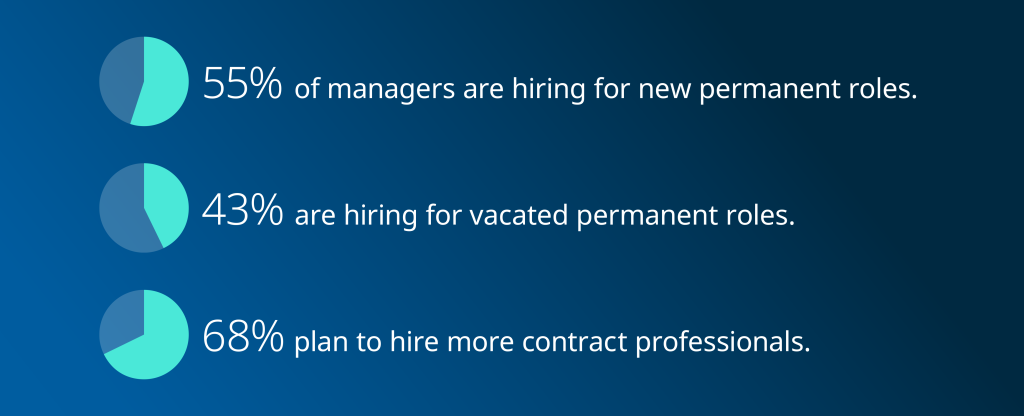By Lucy Marino, Executive Director, Marketing and Creative, Robert Half
In a competitive labor market, the talent you most urgently need often seems the farthest from your reach. Marketing and creative leaders know this feeling well.
Research from Robert Half’s latest Demand for Skilled Talent report finds 55% of marketing and creative managers are planning to expand their teams by hiring for new permanent roles, and an additional 43% are hiring for vacated roles.

HIRING TRENDS:
What’s driving this hiring? Marketing and creative managers cited company growth (70%), employee turnover (68%) and lack of requisite skills among current employees (53%) as the main influences for hiring decisions.
The catch? Almost every marketing and creative manager surveyed is having trouble finding skilled talent in this field: 92% say it’s challenging to find skilled professionals. And one in four hiring managers (26%) said digital and web design and development is the most difficult area to find talent. It’s been especially challenging recruiting professionals with experience in user experience and user interface design, web and mobile design, and information architecture. And the competition for talent continues.
Still, I can assure the talent you need is out there. But first, let’s look at why digital design is so hot right now.
LIVING IN A DIGITAL WORLD:
The way we shop and interact with brands has changed in the years since the pandemic. Online retail has gained ground across all demographics as companies are investing heavily in digital advertising campaigns to drive traffic to their e-commerce platforms.
Global ad market trends clearly reflect this pivot to digital. According to Zenith Media’s Advertising Expenditure Forecasts report, ad spending in North America is estimated to grow 9.8% in 2024 due to the Presidential election and the Olympics. Online advertising, including retail media, search and social media are the fastest-growing categories and are expected to represent 59% of overall global ad spend in 2025.
Given these trends, many brands are looking to invest heavily in digital design over the next few years. But a compelling digital strategy is only as good as the people you hire or promote to execute it.
AMERICA’S GOT TALENT (if you know where to find it):
Top candidates can be found almost anywhere if you have the right hiring strategy and mindset. Your next great hire could be in another state or country — or just down the office corridor. They might have all the skills they need from day one — or be so hungry to learn that you can train them on the job. They might stay with you for years — or add tremendous value during a six-month contract.
In short, keep an open mind as you explore the following options to build your digital design team:
Refresh your sourcing and outreach channels. Talented digital designers may not always be on LinkedIn. These days you’re more likely to find them — and examples of their work — on graphics-heavy sites like Behance and Dribbble. Also, consider where creatives socialize and network online and calibrate your outreach strategy accordingly.
At the same time, don’t neglect traditional sourcing methods such as employee referrals. No one knows your brand and organizational culture like your existing workers, who can recommend people who would likely perform well at your firm.
Explore new talent pools. To give yourself an edge, widen your search for candidates beyond the borders of your city, state or even time zone. Creatives don’t just live in big cities, and we now know remote workers can thrive, especially designers. There’s no doubt people want options for working off-site, be it full-time or a couple of days a week, and the perk can be a big draw for talented creatives.
Another talent pool to consider is former employees. Create an alumni mailing list and ask former workers to stay in touch, leaving the door ajar for boomerang hiring.
Encourage internal mobility. In your rush to hire the people you need, are you sure you’re maximizing the potential of the people you have? Promoting talent from within is more cost effective than hiring externally. And because current employees are known quantities, it’s less risky, too.
Not everyone has the confidence to ask their boss for more responsibilities or a promotion, but that shouldn’t count against them. Be proactive about nurturing talent in your ranks by speaking regularly to employees about their career development and giving stretch assignments to people who have demonstrated growth potential.
Try hiring for potential. There’s a reason perfect candidates are called unicorns or purple squirrels: They don’t exist. In the real world, where everyone is chasing the same talent, you need to be prepared to take a chance on candidates who might not possess all the skills you seek but have the tenacity and potential ceiling to become MVPs.
Start by reviewing your job descriptions and taking a red pen to any nice-to-have skills that aren’t necessary for the role. List too many extras, and you risk driving away talent that hasn’t yet had access to certain experiences or educational opportunities.
Finally, remember that hiring for potential is a long-term commitment. Digital design is a challenging field, and without a thoughtful and comprehensive upskilling program, you could be setting up your recruits to fail.
Marketing and creative firms need many resources to thrive in a digital-first world, including experienced and inspired digital designers. With a flexible, risk-tolerant approach to talent acquisition, you can snag great talent from your competitors.

Robert Half is the world’s first and largest specialized talent solutions and business consulting firm, connecting highly skilled job seekers with rewarding opportunities at great companies. We offer contract talent and permanent placement solutions in the fields of finance and accounting, technology, marketing and creative, legal, and administrative and customer support. Explore talent solutions, research and insights at roberthalf.com.

